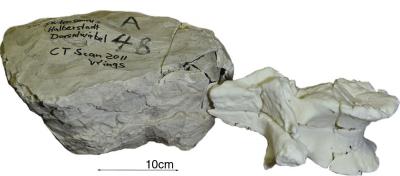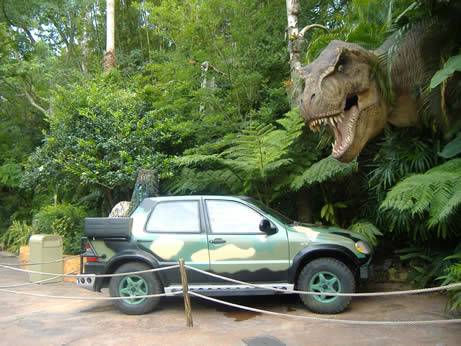Using a CT scan and 3D printer to recreate a fossil
November 21, 2013

A 3D printed object (right) next to the original unprepared plaster jacket (credit: Courtesy of Radiology and RSNA)
Fossils are often stored in plaster casts, or jackets, to protect them from damage. Getting information about a fossil typically requires the removal of the plaster and all the sediment surrounding it, which can lead to loss of material or even destruction of the fossil itself.
German researchers used CT and 3-D printers to nondestructively separate fossilized bone from its surrounding sediment matrix and produce a 3D print of the fossilized bone itself.
“The most important benefit of this method is that it is non-destructive, and the risk of harming the fossil is minimal,” said study author Ahi Sema Issever, M.D., from the Department of Radiology at Charité Campus Mitte in Berlin. “Also, it is not as time-consuming as conventional preparation.”
Tracing an unidentified buried fossil
[+]
Issever and colleagues applied the method to an unidentified fossil
from the Museum für Naturkunde, a major natural history museum in
Berlin.
A future Jurassic Park movie sequel could call on 3D printers for more accurate models (credit: Universal Pictures)
The fossil and others like it were buried under rubble in the basement of the museum after a World War II bombing raid. Since then, museum staff members have had difficulty sorting and identifying some of the plaster jackets.
Researchers performed CT on the unidentified fossil with a 320-slice multi-detector system. The different attenuation, or absorption of radiation, through the bone compared with the surrounding matrix enabled clear depiction of a fossilized vertebral body.
After studying the CT scan and comparing it to old excavation drawings, the researchers were able to trace the fossil’s origin to the Halberstadt excavation, a major dig from 1910 to 1927 in a clay pit south of Halberstadt, Germany. In addition, the CT study provided valuable information about the condition and integrity of the fossil, showing multiple fractures and destruction of the front rim of the vertebral body.
Furthermore, the CT dataset helped the researchers build an accurate reconstruction of the fossil with selective laser sintering, a technology that uses a high-powered laser to fuse together materials to make a 3-D object.
Digital models of the objects can also be transferred rapidly among researchers, and endless numbers of exact copies may be produced and distributed, greatly advancing scientific exchange, Issever said. The technology could enables a global interchange of unique fossils with museums, schools, and other settings.
Abstract of Radiology paper
Purpose — To demonstrate the feasibility of using computed tomography (CT) to confirm the identity of an unprepared fossil and to use the CT dataset to separate the fossilized bone from its surrounding sediment matrix and produce a three-dimensional (3D) print.
Materials and Methods — The examined object was a plaster jacket containing an unprepared fossil. CT was performed with a 320-section multidetector unit. A marching cube-based method was used to transform the voxel CT dataset into triangle-based, editable geometry. Then, a comprehensive postprocessing step was performed to isolate the geometry of the vertebra from its surrounding fossilized matrix. Finally, the resulting polygon mesh describing only the vertebra was used for a physical 3D reconstruction by using a selective laser sintering machine.
Results — The CT examination provided enough data to assign the fossil to the genus Plateosaurus. In addition, much valuable information about the fossil has been gained—in particular the visualization of multiple fractures and the destruction of the anterior rim of the vertebral body. Finally, the results show that the 3D print generated, including the fractures and the anterior destruction, may be considered an accurate copy of the bone with the unprepared fossil.
Conclusion — The authors demonstrated the feasibility and potential utility of combining CT with 3D printing, providing a nondestructive method to future paleontologists.
(¯`*• Global Source and/or more resources at http://goo.gl/zvSV7 │ www.Future-Observatory.blogspot.com and on LinkeIn Group's "Becoming Aware of the Futures" at http://goo.gl/8qKBbK │ @SciCzar │ Point of Contact: www.linkedin.com/in/AndresAgostini
 Washington
Washington